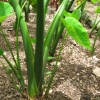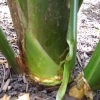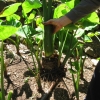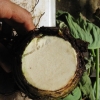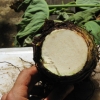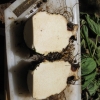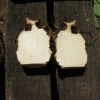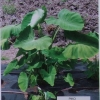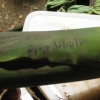Use As Food
A very important commercial poi taro. Goup piko are known to make good poi.
Distribution
Widely planted on all the islands, especially Oahu, almost exclusively under lo‘i (wetland) culture.
General Characteristics
Medium in height, erect, moderately stocky, maturity 12 to 15 months, producing from 5 to 10 ‘ohā; resembles Piko Uaua very closely, but the Hā (Petiole) of Piko Uliuli is white at the kōhina (base), while iko Uaua's kōhina is pink.
Ha (Petiole)
60 to 100 cm. long, dark green, usually edged narrowly with dark pink or red, white at kōhina (base).
Lau or Lu'au(Leaf Blade)
30 to 45 cm. long, 25 to 35 cm. wide, 20 to 35 cm, from tip to base of sinus (māwae), egg-shaped (ovate), nearly horizontal, firm-chartaceous (paper like), light to dark green, piko whitish round leaf section (lobes) obtuse with narrow lihi māwae (sinus).
'I'o kalo (Corm)
Flesh chalky white with yellowish fibers; skin cream-colored.
Pua (Flower)
The flower produces a scent similar to puakenikeni; this was observed by Hiapo Cashman of Kanewai, Hawai‘i. H& #257; (peduncle) green; flower cover (spathe) 15 to 20 cm. long, the lower tubular constricted portion 3 to 4.5 cm. long, green, usually tinged, with red at kōhina (base), usually open partially exposing the ovaries, the upper portion deep yellow ; spadix (spike of flower) 5 to 6 cm. long, the sterile appendage (tip of flower's spike) about 4 mm. long.
Remarks
This variety used to be grown extensively at Ka‘anapali, Maui, a region of strong winds, which caused the leaves to be torn. This tearing led to the local name Haehae, which means to tear to pieces. Piko Uliuli is considered hardier than Piko Kea and shows less rot, especially in the lowlands where the irrigation water is warmer. Piko Uliuli grows well under the hot sun near to the ocean. Piko Uaua and Piko Uliuli are sisters because they both have dark green Hā (Petiole).


